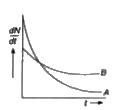The variation of decay rate of two radioactive samples A and B with is shown in Fig. Ep.13.2.which of the following statements are true?
 Solution in Punjabi
Solution in Punjabi
Decay constant of A is greater than that of B, hence A always decays faster than B.
Decay constant of B is greater than that of A but its decay of rate is always smaller than that of A?
Decay constant of A is greater than that of B but it does not always decay faster than B.
Decay constant B is smaller than that of A but still is decay rate becomes equal to that of A at a later instant.
Step by step video & image solution for The variation of decay rate of two radioactive samples A and B with is shown in Fig. Ep.13.2.which of the following statements are true? by Physics experts to help you in doubts & scoring excellent marks in Class 12 exams.
Similar Questions
Sample of two radioactive nuclides A and B are taken. λA and λB are the disintergration constants of A and B respectively. In which of the following cases, the two sample can simultaneously have the same decay rate at any time ?
01:31View SolutionThe variation of decay rate of two radioactive samples A and B with time is shown in fig.

Which of the following statements are true?05:39View SolutionSample of two radioactive nuclides A and B are taken. λA and λB are the disintergration constants of A and B respectively. In which of the following cases, the two sample can simultaneously have the same decay rate at any time ?
View SolutionThe variation of decay rate of two radioactive samples A and B with time is shown in fig.

Which of the following statements are true?04:18View Solutionदो रेडियोऐक्टिव नमूनों A और B के विघटन की दर का समय के साथ परिवर्तन चित्र में दर्शाया गया है। इनमें से कौन-से प्रकथन सही हैं।
 03:23View Solution
03:23View SolutionThe change over time of the rate of dissolution of two radioactive samples A and B is shown in the figure. Which of these statements is correct?
03:23View SolutionThe decay constant of a radioactive sample
02:05View SolutionThe arrangement to store two magnets is shown by figures (a), (b), (c) and (d) in Fig. 13.2. Which one of them is the correct arrangement
05:03View Solution

